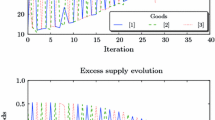Abstract
Motivated by the convergence result of mirror-descent algorithms to market equilibria in linear Fisher markets, it is natural for one to consider designing dynamics (specifically, iterative algorithms) for agents to arrive at linear Arrow-Debreu market equilibria. Jain (SIAM J. Comput. 37(1), 303–318, 2007) reduced equilibrium computation in linear Arrow-Debreu markets to the equilibrium computation in bijective markets, where everyone is a seller of only one good and a buyer for a bundle of goods. In this paper, we design an algorithm for computing linear bijective market equilibrium, based on solving the rational convex program formulated by Devanur et al. The algorithm repeatedly alternates between a step of gradient-descent-like updates and a distributed step of optimization exploiting the property of such convex program. Convergence can be ensured by a new analysis different from the analysis for linear Fisher market equilibria.
Similar content being viewed by others
Notes
Note that the concept of market equilibria is not the same as the concept of Nash equilibria. A market equilibrium does not allow buyers to strategically report their interests in different goods in order to maximize their own utilities.
Jain [15] reduced the equilibrium computation in linear Arrow-Debreu markets to the equilibrium computation in bijective markets.
The projection would be applied to the whole vector b as in [5]. Alternatively, one may apply mirror descents with respect to bi separately and distributedly, and show that, jointly, the objective still converges to minimum (as has been done for congestion games [7,8,9]). This can be left as future work.
W.l.o.g., we assume that \({\sum }_{i\in A}w_{ij}=1\) for every j ∈ A since only wii = 1 and wij = 0 for i≠j in bijective markets.
References
Adsul, B., Babu, C.S., Garg, J., Mehta, R., Sohoni, M.: A simplex-like algorithm for fisher markets. In: Proc. of Algorithmic Game Theory (2010)
Arrow, K.J., Chenery, H.B., Minhas, B.S., Solow, R.M.: Capital-labor substitution and economic efficiency. The Review of Economics and Statistics (1961)
Arrow, K.J., Debreu, G.: Existence of an equilibrium for a competitive economy. Econometrica: Journal of the Econometric Society (1954)
Beck, A., Tetruashvili, L.: On the convergence of block coordinate descent type methods. SIAM J. Optim. 23(4), 2037–2060 (2013)
Birnbaum, B., Devanur, N.R., Xiao, L.: Distributed algorithms via gradient descent for fisher markets. In: Proceedings of the 12th ACM Conference on Electronic Commerce (2011)
Brânzei, S., Chen, Y., Deng, X., Filos-Ratsikas, A., Frederiksen, S.K.S., Zhang, J.: The fisher market game: Equilibrium and welfare. In: Proc. of 28th Conference on Artificial Intelligence (2014)
Chen, P.-A., Lu, C.-J.: Generalized mirror descents in congestion games with splittable flows. In: Proc. 13th International Conference on Autonomous Agents and Multiagent Systems (2014)
Chen, P.-A., Lu, C.-J.: Playing congestion games with bandit feedbacks (extended abstract). In: Proc. 14th International Conference on Autonomous Agents and Multiagent Systems (2015)
Chen, P.-A., Lu, C.-J.: Generalized mirror descents in congestion games. Artif. Intell. 241, 217–243 (2016)
Chen, X., Dai, D., Du, Y., Teng, S.-H.: Settling the complexity of arrow-debreu equilibria in markets with additively separable utilities. arXiv:0904.0644 (2009)
Cheung, Y.K., Cole, R., Devanur, N.: Tatonnement beyond gross substitutes?: gradient descent to the rescue. In: Proceedings of the Forty-fifth Annual ACM Symposium on Theory of Computing (2013)
Devanur, N.R., Garg, J., Végh, L.A.: A rational convex program for linear arrow-debreu markets. ACM Trans. Econ. Comput. 5(1), 1–13 (2016)
Devanur, N.R., Papadimitriou, C.H., Saberi, A., Vazirani, V.V.: Market equilibrium via a primal-dual algorithm for a convex program. J. ACM (JACM) 55(5), 1–18 (2008)
Eisenberg, E., Gale, D.: Consensus of subjective probabilities: The pari-mutuel method. The Annals of Mathematical Statistics (1959)
Jain, K.: A polynomial time algorithm for computing an arrow-debreu market equilibrium for linear utilities. SIAM J. Comput. 37(1), 303–318 (2007)
Kakade, S.M., Kearns, M., Ortiz, L.E.: Graphical economics. In: Proc. of Conference on Learning Theory, pp 17–32 (2004)
Kleinberg, R., Piliouras, G., Tardos, E.: Load balancing without regret in the bulletin board model. Distrib. Comput. 24, 21–29 (2011)
Luo, Z.Q., Tseng, P.: On the convergence of the coordinate descent method for convex differentiable minimization. J. Optim. Theory Appl. 72(1), 7–35 (1992)
Solow, R.M.: A contribution to the theory of economic growth. The quarterly journal of economics (1956)
Zhang, L.: Proportional response dynamics in the fisher market. In: Proc. of Automata Languages and Programming (2009)
Acknowledgements
We would like to thank Ling-Wei Wang for useful discussions.
Author information
Authors and Affiliations
Corresponding author
Additional information
Publisher’s Note
Springer Nature remains neutral with regard to jurisdictional claims in published maps and institutional affiliations.
Po-An Chen supported in part by MST 105-2221-E-009-104-MY3.
This paper appeared in preliminary form in ICCOPT 2019 (the 6th International Conference on Continuous Optimization).
Appendices
Appendix A: Argument of Condition (*) for Theorem 1
We restate the argument of [12] here. Assume that {k} is a singleton strongly connected component without a loop. Let T denote the set of nodes different from {k} that can be reached on a directed path in E from {k}. In an equilibrium allocation, the agents in T ∪{k} spend all their money on the goods of the agents in T, which implies that pk = 0, contrary to our assumption that pj > 0 for every j ∈ A.
Appendix B: Proof of Proposition 1
Let b ∈ Sβ. Consider any i,k ∈ A, j,l ∈ G. First, we have
Let \(p_{j}={\sum }_{i} b_{ij}\). Thus, we have
Next, note that except for i = k, we have
and if i = k, we have
This means that each entry of the Hessian matrix ∇2ϕβ(b) is at most n. Then for any \(\mathbf {z} \in \mathbb {R}^{n\times n}\), we have
The first inequality is by pi ≥ 1. The third inequality is by Cauchy-Schwarz inequality. This implies that ∇2ϕβ(b) ≼ αI with α = n.
Rights and permissions
About this article
Cite this article
Chen, PA., Lu, CJ. & Lu, YS. An Alternating Algorithm for Finding Linear Arrow-Debreu Market Equilibria. Theory Comput Syst 66, 38–55 (2022). https://doi.org/10.1007/s00224-021-10051-y
Accepted:
Published:
Issue Date:
DOI: https://doi.org/10.1007/s00224-021-10051-y




